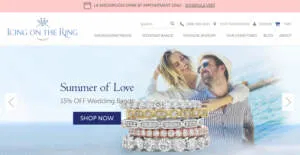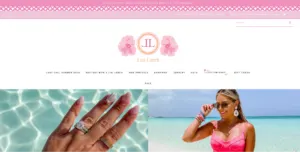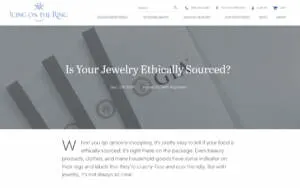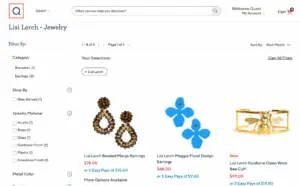How to Sell Jewelry Online and Build a Store That Shoppers Love


How to Sell Jewelry Online and Build a Store That Shoppers Love
Get The Print Version
Tired of scrolling? Download a PDF version for easier offline reading and sharing with coworkers.
A link to download the PDF will arrive in your inbox shortly.
Jewelry is a timeless and powerful part of the human experience.
According to the International Gem Society (IGS), the earliest discovery of jewelry dates back approximately 25,000 years ago. It was a simple fish bowl necklace found in a cave in Monaco.
The significance and meaning of this necklace could have been anything — a gift, a status symbol or even just beautiful decor. Even though we’ll never know the true story, the possibilities are fascinating to imagine.
From the societies of Ancient Egypt to the modern United States, jewelry has helped people express their individuality, love for romantic partners and friendship. It’s hard-wired in our human experiences to enjoy beautiful things, express ourselves, make fashion statements and pass jewelry items down to our ancestors as collectibles.
Simply put, jewelry makes us feel special — and that’s something that every human on planet Earth needs right now.

If you’re thinking about establishing or expanding your own jewelry business online, the timing has never been better.
A New York Times report from December 2020 found that fine jewelry sales were up during the pandemic due to people wanting to treat themselves.
Current forecasts suggest that the worldwide jewelry market will grow to $291.7B by 2025 — up from a forecast of $229.3B in 2019. It’s also estimated that as of 2021, 79% of jewelry sales in the United States came from non-luxury items.
These economic forecasts paint the picture for an expansive global market, with room for newcomers and established industry giants alike. The beauty of jewelry is in its diversity, and platforms such as eBay and Etsy make it possible for the smallest of businesses to find a loyal customer base online.
In this guide, you’ll learn how to step into the thriving (and growing) jewelry economy with an online store that makes you proud.
You’ll learn how to find a niche for your products, create a loved customer experience, identify a technical pathway for building your online store and create the right foundations to help your business scale.
Why You Should Sell Jewelry Online
The COVID-19 pandemic has created a permanent shift to the way that people shop.
Not to mention, public health uncertainties could create safety concerns for people to try on jewelry in stores.
With this context in mind, creating an online jewelry business is a smart move because it’s a safe and efficient way to reach shoppers.
Beyond the practical considerations of safety and efficiency, online retail creates a pathway for people to discover brands that they wouldn’t have come across otherwise.
As a merchant, you have the ability to reach customers anywhere in the world, regardless of where you’re located. Regardless of whether you are an independent jewelry designer on Etsy or part of a team at a larger brand name operation, you have an equal footing to build a discoverable store.
Keep in mind that there were demographic trends in motion even before the COVID-19 pandemic that made the case for selling jewelry online. One important trend to watch is the rise of the Gen Z shopping population.
Shortly before the pandemic began, Gen Z had already accounted for 40% of global shoppers, meaning that they are on the path to becoming the dominant spending force. These individuals have been creating a shift in the way that people of all generations make purchase decisions.
As the first generation of digital natives, this group relies on social media and online retail experiences to discover new products — a trend that has increased during the pandemic, according to the National Retail Federation (NRF).
Research from the NRF has also found that 87% of parents rely on recommendation from their children when deciding what to buy.
These trends point to a historic shift in the way that people shop for new jewelry, which is a timeless cultural staple to our human society. The key to getting started is to find the right niche and to build a brand that stands out.
Market Analysis: Trending Jewelry Brand Niches
When you sell jewelry online, there’s an opportunity to reach people with your brand all over the world. This expansive market means that there’s an opportunity for all retailers — from Tiffany and Cartier to the local costume jewelry store — to attract an engaged and loyal customer base.
The flip side of this growth potential is that there’s also a lot of competition. No matter the type of jewelry, making your brand discoverable can be a challenge, especially since attention spans are tough to capture. Shoppers have a seemingly infinite number of options to navigate their purchase decisions.
Knowing that the market is crowded, the most impactful first step that you can take to building your online store is to identify your niche. In general, most online jewelry stores fall into one or more of the following seven categories:
1. Affordable fashion jewelry.
Ranging from necklaces to bracelets, rings, and costume accessories, fashion jewelry tends to go in and out of style quickly. These pieces tend to be lower in quality and longevity but highly affordable for shoppers who are looking to make a statement.
One way to stay on top of the fashion jewelry market is to browse magazines such as Seventeen, Vogue, Marie Claire, Harper’s BAZAAR, and Cosmopolitan. Influencers on TikTok and Instagram often set the tone for trends.
Fashion jewelry tends to consist of lower quality materials such as imitation metals (i.e. silver instead of platinum) and gemstones (i.e. cubic zirconia instead of diamonds). Designers will often base designs on higher-priced items.
It’s important to keep in mind that the fashion jewelry industry is diverse, however. Pieces may be as inexpensive as $5 or as expensive as $100. Individual items may be mass produced in factories or handmade from independent designers and Etsy shop owners.
“Affordable,” doesn’t always mean “cheap.” But it doesn’t mean “luxury” either.
2. Body jewelry.
There’s an opportunity for jewelry merchants to make a name for themselves in the world of body piercings, consisting of nose rings, belly button rings, tong rings, eyebrow rings and more.
Body jewelry tends to be more personal than bracelets or necklaces, especially due to variations in piercing sizes and allergic reactions to metals. For instance, some people need to opt for certain types of precious metals or implant grade titanium in order to avoid discomfort.
For this reason, body jewelers will often include pieces in different sizes and metal options — both of which can influence cost. Some stores may also offer the option to customize pieces at the request of shoppers.
As an example, a single nose ring could be available in gold, sterling silver, or implant grade titanium with a straight back, L back to the left, L back to the right, screw, or curve.
Among shoppers, there is often a greater variation in preferences due to personal factors such as comfort level, health and piercing placement.
3. Plated jewelry.
Shoppers often enjoy the look and feel of precious metals but are unable to afford the fine jewelry price tag. One option to reach this market is plated jewelry made from inexpensive metals and coated with a precious metal layer.
Examples of plated jewelry include sterling silver coated with 14K gold or sterling silver coated with pure silver. Nickel is also a less expensive material that gets coated with a rare precious metal like gold or silver.
If you sell plated jewelry, it’s important to maintain a close relationship with your manufacturers. For one, you’ll need to be sure that there isn’t any lead in what you’re selling, as the material is known to be hazardous and could put your store at legal risk.
You’ll also need to be clear with potential buyers that the jewelry is coated and not a true precious metal. Keep in mind that some people have allergic reactions to non-precious metals, so your transparency as a merchant is essential to ensuring a sense of safety.
4. Handmade jewelry.
This category consists of “made-to-order” jewelry and includes a level of customization for every buyer. The value to shoppers is that they receive an item that is unique to their preferences in terms of material, color and size.
The drawback of handmade jewelry is that every piece creates time to produce, and production often cannot scale. For this reason, handmade jewelry tends to come from boutique retailers or individuals on selling platforms like Etsy. Made-to-order jewelry merchants tend to be solopreneurs or small business owners.
While handmade jewelry businesses are challenging to scale, that isn’t always a bad thing — there is a market of buyers who appreciate the personal touch and custom experience. Unique pieces may also command a higher price point.
5. Fine jewelry.
The fine jewelry niche consists of precious metals, rare gemstones, and unique designs. Typically, pieces are made in limited and exclusive batches to accompany high price points that can hit values upwards of tens of thousands of dollars.
The allure of fine jewelry is that the materials are rare and craftsmanship is high. Fine jewelry tends to last people lifetimes and become heirlooms for people to pass to future generations.
The majority of shoppers may only make a few, if any, fine jewelry purchases in their lifetimes due to the cost involved. Wealthier buyers may buy high-end jewelry pieces more often and may be more likely to join loyalty programs.
Shoppers often consider fine jewelry to be an investment, as many pieces become more valuable as time passes. For this reason, fine jewelry tends to have high demand and resale value as second-hand pieces.
The most common examples of fine jewelry include diamond jewelry such as wedding rings and engagement rings. People also tend to buy fine jewelry for special occasions.
6. Vintage jewelry.
Vintage shoppers are drawn to the allure of jewelry that has made its way through history and time to reach our modern era. Jewelry is especially popular and practical as a second-hand item due to the timelessness and durability of many pieces.
Vintage items have a strong appeal in the fashion industry due to items being unique, one-of-a-kind or special. Vintage enthusiasts tend to enjoy the discoverability that comes with finding unique items.
Because vintage items are second-hand, each item may have a unique story in terms of their previous owner, historical era or original fashion designer. These origin stories have the ability to increase the value of each item.
Vintage jewelry consists of fashion accessories, handmade items and even luxury items. Some antiques, particularly ones with an interesting story, have the potential to become more valuable over time.
Pricing is often on a case-by-case basis.
7. Fair trade jewelry.
One outcome of the COVID-19 pandemic is that shoppers are becoming more ethical and conscious in their purchases. The jewelry industry, as with many others, has historically had human rights and environmental problems in its supply chains.
For this reason, brands with fair trade practices have the potential to make a name for themselves as socially responsible brands. Examples of conscious business practices include paying workers above-market wages, sourcing supplies directly from farmers, using recycled materials and partnering with local communities to create a greater sense of wellbeing.
All types of jewelry have the potential to incorporate fair trade, sustainable and conscious business practices. All jewelry companies have a role to play in creating higher standards for the industry.
How to Sell Jewelry Online in 7 Steps
The rise in available ecommerce technology means that anyone can set up an online jewelry store in a matter of minutes. But a successful jewelry business, whether you’re building a new storefront or expanding an existing one, involves creating an overarching brand strategy.
Ultimately, your store needs to leave a lasting impression in the mind of each shopper. It’s not enough to simply put your products online — every digital touchpoint needs to communicate a compelling, memorable and engaging story that makes people feel inspired and uplifted.
Jewelry is a special purchase with value beyond the cost of the item. People wear necklaces, earrings, bracelets and other statement pieces to feel good about themselves and express their personality.
The following steps will help you build the foundations for a loved digital experience:
Step 1: Gather inspiration from online jewelry stores.
Ecommerce experiences are a product of the imagination. But there is no need to reinvent the wheel, as there are plenty of existing top performers in the space.
Before building your store, take a look at what key players are already doing. With this perspective, you’ll come away inspired with valuable recommendations to integrate into your own brand.
As you go through this exercise, take a look at how different websites focus on the following attributes:
User-friendly design.
Shopping cart functionality.
Mobile optimization.
Promotional campaign management.
Seasonal collections.
Product descriptions and details.
Specifications.
Virtual try-on features.
Seamless checkout.
These attributes, together, create a customer journey that establishes a sense of empathy with your buyers. Successful online jewelry stores help shoppers feel special and enjoy the experience of browsing what they are buying.
One example that we love is BigCommerce customer Icing on the Ring, which is a 50-plus-year-old fine jewelry retailer that began as a custom jewelry store with made-to-order products.
Since moving online, Icing on the Ring has built up an inventory of more ready-made items that shoppers can easily browse and purchase with a credit card or via PayPal.

You’ll notice that the Icing on the Ring website feels like a showroom with a clear story. Visitors can browse through quality products while also engaging in a learning experience. For example, Icing on the Ring publishes educational materials about the gemstones and materials that it uses.
You’ll also notice that social media is a core part of Icing on the Ring’s website experience. Website visitors can shop for products that they love on Instagram (and browse through Instagram posts from fellow customers for inspiration).
Step 2: Build your feature wishlist.
As an outcome of Step 1, you’ll have a good idea of how to build an enjoyable brand experience for your online jewelry store. Now, you can start putting what you observe on paper as two lists: “must haves” and “nice to haves.”
From a human interest point of view, what website features will make the brand experience as successful as possible to shoppers? If you’re part of a larger ecommerce team, it may make sense to create a cross-functional group of stakeholders that include your marketing, revenue and technical teams to build a list that captures everyone’s valuable perspectives.
Example must-haves could include:
Integrations with social media platforms like Twitter and Instagram.
Prominent reviews.
1-click checkout.
Coupons.
High quality photography with multiple views.
Mobile optimization.
Potential nice to haves could include:
Seasonal collections.
Advanced payment options such as financing.
Live chat for instant customer support.
Video or augmented reality content.
Keep in mind that the lists you create, at this stage, will not be comprehensive. Rather, they offer a starting point to begin identifying your short-term, medium-term and long-term priorities.
For inspiration, take a look at BigCommerce customer Lisi Lerch, a fashion accessories designer that specializes in statement pieces. You’ll notice that the website supports its core lines of business: ecommerce sales, custom bags, and relationships with resellers. A single website experience orchestrates multiple lines of business into a cohesive and integrated brand.

Your own website will evolve over time, and as your business grows, you will start to incorporate more features to your online store.
Your goal, at this beginning wishlist-building stage is to establish a foundation for your frontend and backend operations.
Step 3: Decide whether to expand your development team.
By the time you reach this step, you’ll have a clear, tangible perspective on what you’re looking to build with your ecommerce presence. Now, you can start thinking about how to bring your ideas to reality.
The essential question at this step is whether you can do it all yourself. If your company has an in-house ecommerce team with skilled developers, then you may have a handle on it. If you’re a solopreneur looking to sell your products on Etsy, eBay, or Amazon, then you may not need development and engineering resources at all.
But if you’re looking to build something that is larger scale, more expansive and more custom than something that requires a simple design, you may need to reach out to a team of experienced ecommerce strategists and technologists for help.
At the very least, even if your team has expertise in-house, you may benefit from working with consultants who can anticipate the potential for problems before they have a chance to happen.
Working with a team of consultants, especially at the initial stages, can help you reduce the uncertainties and costs that come with bringing your vision to market.
Step 4: Select a third-party ecommerce platform.
You can think of your ecommerce platform as the central hub for your business operations. It is a command center for managing everything from your website experience to your inventory, shipping, marketing, security and compliance practices.
Ecommerce platforms are multidimensional technologies that stitch together the various components you need to run a successful and scalable ecommerce operation. Especially as your business grows, it will become impossible to run your operation without this technology.
The benefit to using a third-party ecommerce solution rather than building your own in-house is that you get better, more trustworthy and more reliable software.
When you build ecommerce software in-house, you’re responsible for managing and maintaining everything. If there is a security breach — or if there is a shift in a country’s regulation that necessitates a compliance update — the burden falls on you to make all of these changes.
Third-party ecommerce platforms have teams working behind the scenes to ensure an up-to-date, smooth solution that is user friendly and secure. Because these technology providers work with different types of stores as customers, you’ll often find the features you need to run your store bundled into the core offerings.
The key to choosing the right ecommerce platform is to identify the backend and frontend technical components that are most important for your unique jewelry business and customer experience.
Major ecommerce platforms include BigCommerce, Magento, Shopify and WooCommerce.
The right ecommerce platform should:
Support your core site functionalities.
Support the number of API calls necessary for the course of everyday business.
Support the compliance requirements of the geographies in which you sell.
Provide innovative solutions to your business complexities.
Accept the plugins (e.g. search engine optimization, social media) you need to run your online jewelry store successfully.
Integrate within your existing technology stack, including your customer relationship management (CRM) software.
Choosing the right ecommerce platform is a decision with long-term consequences to your business and so it’s important to make the right judgment call at the beginning stages.
This Guide to Choosing the Right Ecommerce Platform will help you make a decision that supports your jewelry business’s goals.
There is no one-size-fits-all solution — every business is different.
Step 5: Build your integration ecosystem.
With your core ecommerce platform in place, the next step is to integrate different systems into a consolidated technology. Most jewelry stores will require multiple pieces of software to run efficiently. Your technology stack is what enables your backend and frontend systems to orchestrate your operations.
Here are some of the components to consider:
Your payments processor enables you to process transactions safely and securely online. Example payment processors include Stripe, PayPal and Square. The key is to choose technology that is compliant with the regions in which you’re planning to do business. Payment processors should also include built-in systems for verifying buyers, protecting their data, and preventing fraud. You can read more about the payment processors that come pre-integrated within BigCommerce.
With order management and fulfillment software, you can maintain a real-time picture into your business operations. At any given moment, you have a direct lens into how much stock you have in your warehouse and whether you are fulfilling orders efficiently. Your order management system can also help you with updates to your customers and help you anticipate when you need to secure more inventory. You can see some of the order management and fulfillment apps that BigCommerce supports in its integration ecosystem.
Marketing automation and customer relationship management (CRM) software helps you build a growth layer for your core ecommerce business. The idea is to organize customer information in a way that you can build tailored marketing programs across customer touchpoints and channels. Marketing automation consists of personalization, email marketing, social media, and loyalty program software — a CRM is where you organize all of your customer data so that you can continually connect your marketing activities to purchase patterns. For specific examples, take a look at some of the marketing automation apps that are part of BigComemrce’s integration ecosystem.
Address verification software helps make checkout processes smoother, particularly for shipping and fulfillment. When someone places an order, your store will need to collect personal information for shipping and delivery. It’s common for typos to occur, which can cause shipping delays or returned orders. Address verification software can help protect businesses and shoppers from these issues by using technology to verify shipping details as correct (or incorrect) in real-time.
For jewelry businesses, especially, software is crucial for managing the many moving parts of the shopping experience. Companies need a way to track items as well as making sure that shoppers have a level of transparency into their purchases. A company’s behind the scenes technology stack is crucial for ensuring a sustainable business with the potential to scale.
Step 6: Establish your customer service foundation.
Just like in the physical world, customer service will be an important part of a jewelry business’s success. It’s common for shoppers to have questions beyond what your product details communicate, particularly with respect to sizing, materials and store policies.
With upfront customer service processes, you’ll help shoppers make more informed decisions before committing to their purchases. These informed decisions will help protect your business margins by increasing your revenues and decreasing costs that come with high return rates and restocking of items.
Customer service is a strategic investment in your jewelry business, and you can use a variety of tools to execute a successful strategy. Examples include:
Live chat software.
Messaging centers.
Knowledge hubs with answers to frequently asked questions.
Access to a personal shopping assistant.
The level of customer support that you can provide depends on the size and complexity of your business. Regardless of the level of service that you provide, the key is to be clear with your shoppers around the timing of your response.
If you’re looking for tips to build a customer support strategy using BigCommerce, take a look at this in-depth article for practical tips and software recommendations.
Step 7: Build the human-side of your business operations.
Even with the best technology in place, you need to make sure that your various ecommerce business operations have the right level of human-support.
As your online jewelry business grows, you need to make sure that you have people with the right skill sets overseeing everything in place. Based on the list above, you’ll need people who can closely monitor the following:
Marketing.
Customer success.
Online operations.
Technology.
Revenue.
At the beginning stages of your ecommerce business, one person may be able to function as a “general manager” for all of these roles. That person may hold the job title of “ecommerce manager” or “head of revenue management.”
Over time, as business functions expand, you should expect to hire more specialized people.
This individual will need to work closely with the team that oversees your physical business operations, to ensure a cohesive and unified brand experience.
Build a High-Impact Marketing Strategy
You can think of your ecommerce store as the home base for your jewelry brand. It’s a destination for audiences to visit. As with places to visit in the physical world, you need to help shoppers find their way to what you have to offer. That process involves creating an online presence that spans multiple platforms.
In marketing language, the expression of your brand through its online presence is called an “omnichannel marketing strategy.” Beyond sending people to your online storefront, your online presence can help you collect personalization data to build a more on-target, relevant and enjoyable brand experience.
Here is a template to guide you through the process of building a meaningful online presence:
1. Build a social media presence.
An Instagram presence for your jewelry store is a must. Other platforms to consider include Facebook, Twitter, TikTok and YouTube.
You don’t need to be present on all social media platforms. Rather, pick several — build up each one, one at a time.
One example to consider is Icing on the Ring’s Instagram feed, which includes helpful product photography. Audiences can easily discover and learn more about the items that Icing on the Ring sells.
The brand uses a mix of static images and dynamic videos to create an engaging experience.
Icing on the Ring also encourages its customers to share their own photos using the hashtag #icingonthering.
Customers can also participate in Icing on the Ring’s social media campaigns by submitting original photography through a form on the ecommerce website.

2. Create loyalty incentives.
Jewelry is often a high consideration purchase, meaning that people give careful thought to what they are buying. Especially if your brand is a fine jewelry retailer, it may take several months of browsing before a shopper is ready to make a purchase.
Given that jewelry is a high-consideration purchase, shoppers may feel inclined to compare prices and items across different brands. A rewards or loyalty program creates an incentive for people to make their purchases with your company.
3. Launch a newsletter.
Sometimes, people aren’t ready to engage with your brand in a way that drives a transactional outcome. In these moments, an email newsletter is a valuable marketing channel for keeping shoppers interested in your jewelry brand and products.
A successful newsletter will be entertaining to read beyond being a sales pitch for your products. For this reason, it is important to communicate a clear value proposition for subscribing.
4. Create a content marketing and search engine optimization (SEO) strategy.
Content marketing is the practice of creating branded education in the form of articles, videos and images. It is an effective strategy in today’s media-driven world where people are researching items before making purchases. Coupled with content marketing is search engine optimization (SEO), which is the practice of making content visible on Google based on keywords.
To succeed with SEO, your marketing team will need to identify keywords that are relevant to your brand and develop content, accordingly.
An example content strategy to check out is Icing on the Ring’s education center, which allows audiences to learn more about buying jewelry. As an example, take a look at the following article, which describes Icing on the Ring’s ethical sourcing practices.

Icing on the Ring’s blog, which features a collection of interesting articles, is another example of content marketing:

It’s important to prioritize content marketing as a measurable strategy. For instance, you can track whether a shopper has engaged with content before making a purchase.
5. Build paid media advertising campaigns to build awareness and drive sales.
With an established brand presence, your jewelry brand will be well-positioned to find success using paid media advertising. The idea is to participate in the digital advertising ecosystem to build awareness around your brand — and to re-engage audiences through the consideration process.
Social media companies such as Facebook (which owns Instagram), Google (which owns YouTube) and Twitter provide options to purchase spots for advertising. You can also reach out to publications and blocks to see if there are spots available for direct advertising.
Keep in mind that there are many different advertising products available for different types of businesses. As a jewelry brand, to guarantee the biggest impact from your paid media investment, it will be important to make sure that you choose advertising solutions that support your revenue goals.
For more information about paid media, take a look at this comprehensive and thorough article breakdown.
6. Work with influencers to build brand awareness and trust.
An influencer is someone with a social media presence, who has the ability to persuade how people shop. Influencers have a high degree of authority as trustworthy sources of information.
“Be it moody photos, cheeky video reviews, meandering blogs, or blurry soon-to-disappear Stories, the value of the content in question is derived from the perceived authority—and, most importantly, authenticity—of its creator,” explains Paris Marineau for Wired.
Influencers are receptive to working with brands to promote their product. But keep in mind that campaigns need to do more than just sell — strong partnerships between influencers and brands are built on the alignment of values.
BigCommerce recently published a guide to building a powerful influencer marketing strategy, which you can check out here.
7. Collaborate with resellers and distribution partners.
This technique isn’t the right fit for every brand. But if you manufacture your own products, you may find success working with partner retailers to sell your products on your store’s behalf.
An example to model is Lisi Lerch, whose products appear both on the brand’s website and on retail platforms such as QVC.

This type of distribution relationship is a valuable way for Lisi Lerch to increase brand awareness. QVC is a platform where shoppers can discover Lisi Lerch as a designer. This discovery process creates a funnel of shoppers to the Lisi Lerch ecommerce website. The brand name also becomes more recognizable.
Distribution and reseller relationships are powerful pathways to build brand awareness. It’s important to choose partners carefully; however, and make sure that your company has enough wiggle room to take a healthy profit margin on sales.
It’s also a good idea to loop in a lawyer who can advise on issues related to usage rights for product imagery and brand communications. Terms and conditions will be an important part of your strategic plan.
8. Incorporate reviews into your marketing.
Testimonials and product reviews are important components of your jewelry marketing engine. As humans, we are naturally inclined to trust our peers for insights.
In one study, researchers found that given two similar products, people are more likely to purchase the one with more reviews — even when the less-reviewed option was of higher quality.
For a high consideration purchase like jewelry, reviews can empower shoppers with a sense of confidence. Reviews are one of the most informative pathways to help ensure that we will be happy with what we’re buying.
Reviews can be a part of your marketing in a few different ways:
Featured on your website.
Part of a social media hashtag campaign.
Included in ad copy.
Incorporated into a buyer’s guide.
Highlighted in an email marketing campaign.
The most impactful reviews include meaningful stories that are relatable and enjoyable to relieve. The role of the brand is to help facilitate peer-to-peer discussion.
The Final Word
The online jewelry industry is booming, with plenty of space for newcomers and established companies, alike. You can think of your ecommerce store as a central hub for your brand, to magnetize audiences and build trust with shoppers.
Selling online requires a balancing act between technology, marketing strategy and human operations. You can think of a digital storefront as a virtual space where you’re bringing people together — just as you would in the real world.
The right technology and processes will help ensure that people enjoy their experience with your brand and remain engaged for the long-term.
Whatever you do, don’t cut corners in building your foundation. The digital future of your company begins with the first step that you take.
FAQs About Selling Jewelry Online
What types of jewelry can I sell online?
Any type. Handcrafted, wholesaler, customizable, necklaces, rings, silver, or gold jewelry.
With the right ecommerce platform, you can easily manage different product categories making the options endless.
Should I have my own site or sell on marketplaces like Etsy, Amazon or eBay?
Selling on your own site comes with many more benefits compared to selling on a jewelry marketplace or another online marketplace.
Some of these include eliminating direct competition on the same site, the ability to create a user experience design that speaks to the brand, direct customer service support, and better promotional management.
Hint: you have much more growth potential by launching your own site.
Can I dropship jewelry?
Yes, with caution. Dropshipping can be a cost effective and timely shipping and fulfillment method for your business.
However, as you grow, you may not want to use dropshipping as your single shipping fulfillment method, due to the low profit margins associated with it.
If I dropship, how can I determine if the jewelry I am selling is real?
Do your research. Evaluating a quality wholesale supplier is the first step in determining if your products are authentic.
Once you have selected your supplier, have products sent to you to evaluate quality and price.
Repeat this process every quarter to ensure the quality of your products remain the same.

Ritika is an educator and storyteller who enjoys making complex topics easy to understand. She also teaches writing and has helped more than 300 companies level up their narrative building capabilities


